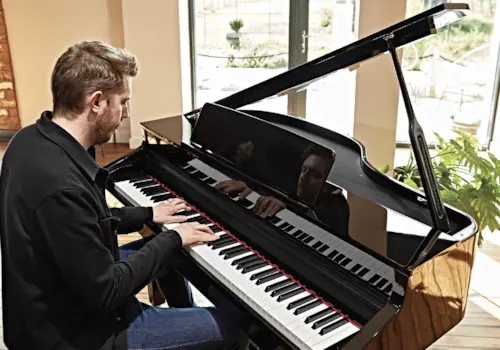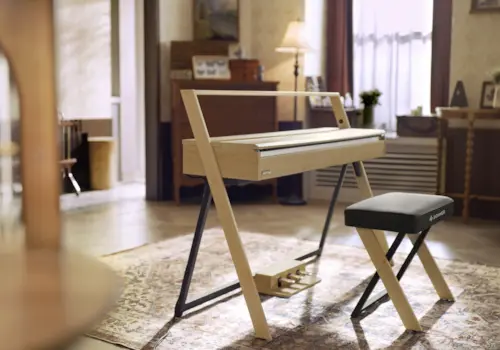20 September 2025
|
Sight-reading is an invaluable pianistic skill that is worth practising from the very start of your learning journey. Michael McMillan rounds up the many publications on offer that will put your eyes – and your fingers – to the test
The ability to play at sight is an immensely valuable skill that enables and accelerates the process of learning new repertoire. It’s often neglected, though, and if it is untended for too long there will inevitably come a point where one’s reading ability becomes too weak to register effectively against increasingly complex notation. Progress will slow, and when the burden of reading outweighs the joy of the music-making, the outlook is bleak.
There are essentially three types of sight-reading books on the market to help ward off this predicament: The first type contains pieces that are homogenised in terms of their difficulty to a specified standard. The second type provides exercises and instruction to work on the nuts and bolts of the reading process.
And the third type features progressive difficulty, gradually adding musical features to facilitate digestion. Each type of book has its place depending on an individual’s needs.
FIRST THINGS FIRST
The first type of book – music to practise reading at sight – is exemplified by ABRSM’s Specimen Sight-Reading Tests and More Piano Sight-Reading. These are available from Initial to Grade 8, whilst Piano Specimen Quick Studies provides samples of diplomalevel tests.
These are not instructional books, but simply show what to expect in an exam, and they fulfil this purpose with perfect utility. The benefit to one’s sight-reading ability is derived through exposure to new music, and this is also the raison d’être for Faber’s Improve your sight-reading! A piece a week (available from Initial to Grade 8) where the goal is to learn a piece every week, thereby increasing the strength of sight-reading muscles through greater exercise.
The theory is sound, although success depends on the compliance of the student, who may not wish to spend a whole week preparing such pieces. Plenty of music, along with a spoonful of guidance, is provided in Edition Peters’ Right@Sight series. In the first half of each book, the pieces are prefaced by introductory notes that discuss Time, Rhythm, and Key, encouraging mental preparation of the music.
In the second half, there are no such annotations. It helps that many of the pieces sound 56 good, although the level of difficulty is harder than expected in places. At Grade 6, for example, almost all the pieces in the second half are a full page. Sight-Reading Made Easy (Stainer & Bell) adopts a similar approach in the higher grades, highlighting which aspects of the music to observe.
Again, the calibration of difficulty seems high; although the presentation is dated the advice given is apt and the musical choices are attractive.
Joining the Dots (ABRSM) is subtitled ‘A Fresh Approach to Sight-Reading’ because the material, of uniform difficulty, is organised by key. This allows the reader to head straight to the section that uses the same key of a piece or scale they’re learning, although I’m not convinced this has any benefit beyond convenience.
Difficulty is aligned with ABRSM’s Grades 1-8 requirements, and the range of keys is defined by the syllabus parameters. Short exercises aid familiarisation with each key, and these are followed by a few pieces in the same mould as those found in the Right@Sight series.
Neil Kjos’s Sight-Reading books, which are graded from Preparatory Level (equivalent to ABRSM Initial) to Level Ten (around Grade 8/ARSM), include some original music by the authors – Diane Hidy and Keith Snell – but much of the music has been selected from the 17th- to 20th-century repertoire, featuring composers such as Le Couppey, Berens, Schubert, and Bartók. This variety is important in order to recognise and become familiar with the notation of the characteristic textures, rhythms, harmonic language, and style from different periods.
AWAY FROM THE MUSIC
At the opposite end of the spectrum from these repertoire-based books are those that focus on improving the underlying processes involved in reading notation, namely pitch and rhythmic recognition. David Richard’s self-published Daily Drills provides reading exercises that isolate the rhythmic component by writing everything in crotchets and then varying the pitch. The four pages of clapping exercises reverse the process, focusing solely on deciphering note values.
More exercises in place of the nine pages of ‘bonus pieces’ and three pages of manuscript paper would be preferable but this can be used profitably up to Grade 1. Plenty of determination would be needed to get through the 534 short exercises that make up Progressive Sight Reading Exercises (Associated Music Publishers).
No text is included except for a three-sentence preface, which is followed by lines of semibreves in C and G positions. Rhythmic complexity is methodically increased, followed by changing time signatures, accidental sharps, flats, and then a mixture of the two. All the exercises are written in a five-finger position, and no chords are used throughout. The presentation is squashed at times, making engagement with the music less appealing.
EMBRACING THE TWO
The remaining books include incrementally difficult pieces and varying amounts of instruction and reading exercises. Beginning with books for children, three Notespeller & SightPlay books from Alfred’s Music for Little Mozarts series have been tailor-made for beginners around five to six years old.
Attractively presented with plentiful illustrations, every page includes an activity such as drawing or colouring to reinforce concepts introduced in their Music Lesson books. Only American terms are used for note values, but this is a commendable set for students needing extra support at this early stage.
Piano Time Sight-Reading (OUP) is a collection of three books supplementing the popular Piano Time series. Suitable for slightly older children and reaching a higher range of difficulty (around Grade 2), the presentation is neat and simple, and cute icons remind the player to watch out for certain musical features.
Fun activities are dotted throughout the books, although the pacing seems rather fast in the first book, with tied notes introduced on the first page and both G and F major appearing on the second page. Alfred’s Basic Piano Library Sight-Reading enjoys a gentler upwards gradient.
These books coordinate with the corresponding Lesson Book, focusing on reading intervals within hand groupings, and the method opts for the smart strategy of engaging the learner with chords from the early stages. Since the books are geared to complement Alfred’s piano course, if you’re not already invested in their system some care will be needed to make sure the material fits the rest of your curriculum.
The same can be said about Alfred’s Sight Reading books for the ‘later beginner’, and for adults. The child-orientated presentation in SightReading for Young Pianists (Poco studio) with colourful pages and stickers does an excellent job of sweetening rigorous content that would otherwise be unpalatable for young attention spans.
Sadly, this is only available for Grade 1.
Faber’s Improve your sight-reading! includes a small dose of rhythmic (clapping) exercises, prepared pieces prefaced with questions like those in the Right@Sight books, pieces that include dynamic directions and tempo/character indications, and pieces that don’t mention either. Each book is divided into stages that zoom in on a new musical feature such as a time or key signature in accordance with either the ABRSM or Trinity syllabus requirements (books are available for both). The progression is logical and coverage is thorough.
Similarly well-organised and clearly presented is Trinity’s Sight Reading Piano – a progressive method which covers Initial to Grade 8 levels. There are ten lessons for each grade, with each lesson consisting of four or five short pieces with a particular focus on an aspect such as compound time, or dotted minims, and this is followed by an eight-bar duet. After the ten lessons, there are a reasonable clutch of specimen tests.
The emphasis is on learning to read in context rather than in isolation, and each lesson provides enough material for a week; the duet provides a fun activity for lessons. The Sight-reading Sourcebook (Chester Music), available at Grades 1-3, offers a few rhythmic exercises and then around 70 (Grade 3) to 100 (Grade 1) one or two-line progressive pieces. Those in the Grade 3 book often start halfway across a line, which may save paper but makes the presentation look untidy. Presentation is the main reservation in Sight-Reading for Fun (Stainer & Bell), particularly in the higher grades where the musical print is too small. T he advice given is sound, but there is a mismatch between the difficulty of the pieces and those found in the ABRSM specimen tests. Faber’s Play at Sight is aimed at the lower grades (Initial to Grade 2). A couple of sentences at the top of each page detail the specific point of the musical content, and the melodic exercises are intended to be completed at a rate of a page per week, meaning that the book will take 59 weeks to complete.
It is light on instruction, but this is a systematic course that would benefit an older beginner. Piano Sight-Reading and More Piano Sight-Reading (Schott) are both published in three parts. They aren’t linked to any graded syllabus, but take the reader from Initial to Grade 8.
Exercises are plentiful (over 300 are in the first set of books), and descriptions of new elements are concise. Plenty of duets are included in the supplementary volume, and, at the third level, there are novel exercises involving accompaniments, transpositions, 58 and harmonisations that develop useful real-world practical skills. The plain presentation is best suited to older learners but this is a noteworthy set. Sight Reading Success (Rhinegold) caters to the first five grades.
The main point of differentiation here is that the books all come with a CD. In principle this seems a good idea, since you can hear rhythmic demonstrations and how pieces should sound. In practice, though, I wonder how many people have a CD player readily available and are prepared to use it to practise their sight-reading.
The exercises are perfectly appropriate for the respective grades but the written instructions are rather too detailed, and including them on the audio recordings is surely unnecessary.
AND FINALLY…
Rounding up this survey are a couple of series of books with more emphasis on learning to read. How to Blitz! Sight Reading (Chester Music) is a three-part series from Grades 1 to 5. Imaginative exercises and musical games are used to increase rhythmic awareness and pitch cognition, with tests dotted throughout the books to check understanding. Pieces to sight-read provide musical context, and stickers are included to use as motivational treats if necessary.
The presentation is rather enthusiastically wordy and congested, though, and the workbook-like feel may not be to everyone’s liking. Finally, Piano Safari is a fairly recent three-book course developed by a couple of American piano teachers. Their method focuses on reading by intervals and provides theory pages and frequent rhythmic exercises, all spaciously presented. Chords are introduced early on, and the fingering is changed up, encouraging students not to associate notes with a certain hand position.
The progressive gradient is shallow, so the third book reaches around Grade 3. An extra feature of this method is the A5-sized Sight Reading & Rhythm Cards, sold separately. These provide plenty of additional practice material, served in manageable daily portions.
Whether a student requires material to read at sight in order to sharpen their proficiency, or some instructional exercises to help their understanding of notation, with such a diverse selection of books there’s absolutely no excuse to let sight-reading skills slide!







